Bulletin – March 2016 Australian Economy The Labour Market during and after the Terms of Trade Boom
- Download the article 996KB
Abstract
During the terms of trade boom, strong growth in output prices meant that the real cost of labour declined from the average firm's perspective and demand for labour increased. At the same time, the appreciation of the exchange rate helped contain the increase in consumption prices, so the purchasing power of employees' earnings rose and growth in the labour force picked up. Australian employment grew strongly and the unemployment rate fell.
Since 2011/12, the terms of trade have declined substantially. The mining investment boom is coming to an end and the less labour-intensive phase of resource production has begun. However, low interest rates and the depreciation of the exchange rate have supported labour demand in other sectors. Firms' output prices and unit labour costs have been little changed since the peak in the terms of trade, though there have been differences between industries. Growth in employee earnings is no longer outpacing growth in consumption prices, encouraging firms to retain or employ more workers than would otherwise have been the case. Growth in the labour force has also responded to changes in labour market conditions, and population growth has slowed. This labour market flexibility has helped to smooth the adjustment following the end of the terms of trade boom and limit the increase in the unemployment rate.
Background
Australia's terms of trade increased markedly between 2003/04 and 2011/12, as a sharp rise in commodity prices led to a dramatic increase in Australia's export prices (Graph 1). As a result, in aggregate, firms could sell their output at higher prices (Graph 2). Meanwhile, consumers did not see their living costs increase to the same extent, aided in part by lower import prices following the appreciation of the Australian dollar. This change in output and consumption prices improved the welfare of Australian households and the profits of Australian firms.[1] More recently, the terms of trade have declined and the Australian dollar has depreciated, leading to some reversal of the earlier relative price movements. Firms' output prices have been little changed in aggregate, while consumption prices have continued to increase.
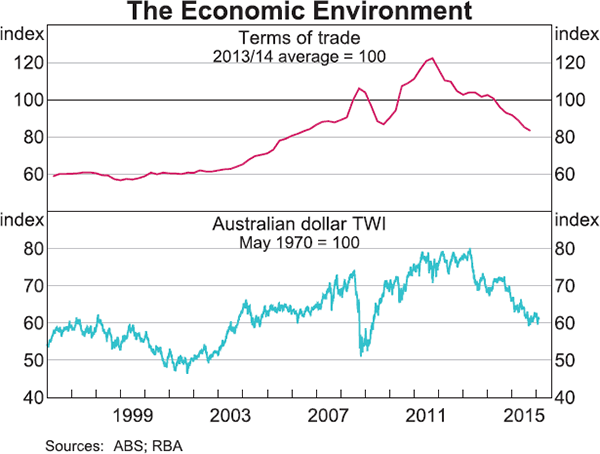
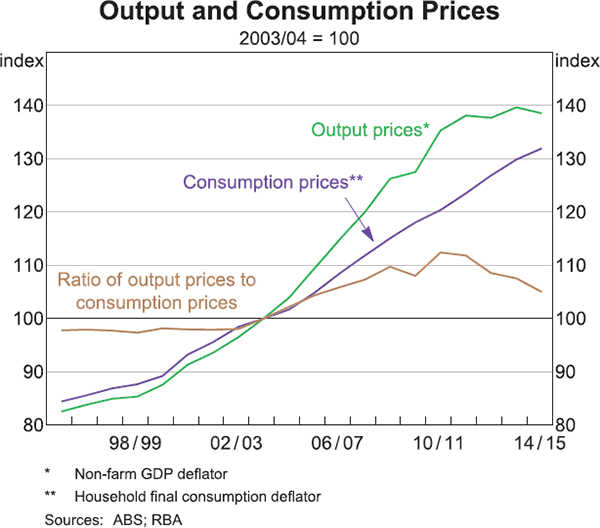
These relative price movements have influenced firms' demand for labour and the attractiveness of employment to households. Firms' demand for workers is influenced by the cost of labour and the output it can produce, relative to the price at which that output can be sold. The real cost of a unit of labour is determined by the real production wage (that is, employee average hourly earnings relative to output prices) as well as labour productivity (output per hour worked).[2] A decline in real unit labour costs is roughly equivalent to an increase in firms' profits as a share of income. During the terms of trade boom, average real unit labour costs declined: the cost of hiring an additional worker was relatively low compared with the expected price of the output that the worker could help to produce and, therefore, firms tended to hire more workers. Firms generally sought to expand their production capacity to take advantage of high output prices, which led to an increase in demand for productive resources such as labour and capital and, in turn, to higher growth in employee earnings.
Workers' perceptions of the benefits of working depend on the purchasing power of their earnings relative to the prices of items they consume. This is known as the real consumption wage (employee average hourly earnings relative to the household final consumption price deflator). As demand for labour increased during the boom, employee earnings growth picked up and outpaced inflation in consumption prices, which were restrained by the effect of the appreciation of the exchange rate. The increased purchasing power of employee earnings and improved job prospects was associated with more people entering the Australian labour market.
This article examines how the terms of trade boom and exchange rate movements have affected real wage growth, labour demand and supply. First, the labour market effects of the upswing in the terms of trade and exchange rate between 2003/04 and 2011/12 are discussed; further detail can be found in Plumb, Kent and Bishop (2013) and Downes, Hanslow and Tulip (2014). Second, developments during the unwinding of the boom are outlined. In each section, changes in output prices, labour costs and labour demand are first analysed from the perspective of businesses. As movements in prices and employee earnings have not been uniform across firms, three broadly defined sectors are considered: mining, non-mining tradeables and non-tradeables.[3] Lastly, the effect on households is discussed, considering the impact of relative price changes on the real consumption wage and the accompanying changes in the labour force.
During the Boom: 2003/04 to 2011/12
The effect on businesses
As has been well documented, the rise in demand for commodities that drove the increase in global commodity prices and the terms of trade boom meant that Australian mining firms' output prices rose sharply (Graph 3). To take advantage of higher demand and output prices, mining firms sought to increase their production capacity. This led to an increase in the demand for productive resources, such as labour and capital.
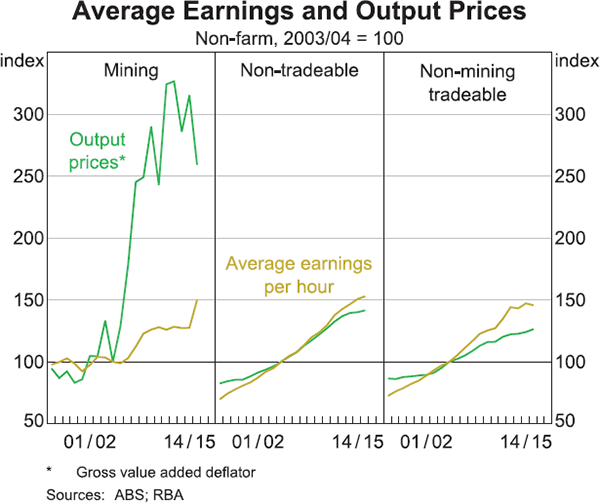
The mining sector offered higher wages to help attract additional workers from other sectors and from overseas, given the limited spare capacity in the Australian labour market at the time. Consequently, employee earnings rose sharply in the mining industry in the early stages of the boom. However, the increase in earnings necessary to attract the labour desired by the mining sector was much less pronounced than the increase in output prices. Therefore, the mining real production wage declined (Graph 4).
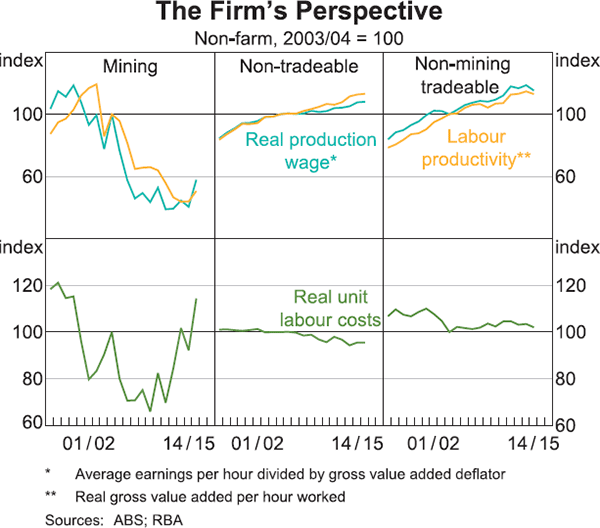
At the same time, mining labour productivity fell because additional workers were hired to expand mining capacity, but it would take some years before this new capacity was ready to produce extra output. The rise in commodity prices also gave firms an incentive to hire workers to mine more marginal resources, which also contributed to a decline in mining output per hour worked.
Nevertheless, the real production wage in mining fell by more than the decline in labour productivity, and the real unit labour costs faced by the mining industry decreased. This decline in real unit labour costs was roughly equivalent to the fall in wages as a share of income (Graph 5). Mining firms were able to capture a larger share of the sector's rising income than in the past. In those circumstances, mining companies may have been less concerned about containing costs, including labour costs, than they have been more recently. Moreover, there was an incentive to pursue investment opportunities quickly in order to take advantage of high commodity prices.
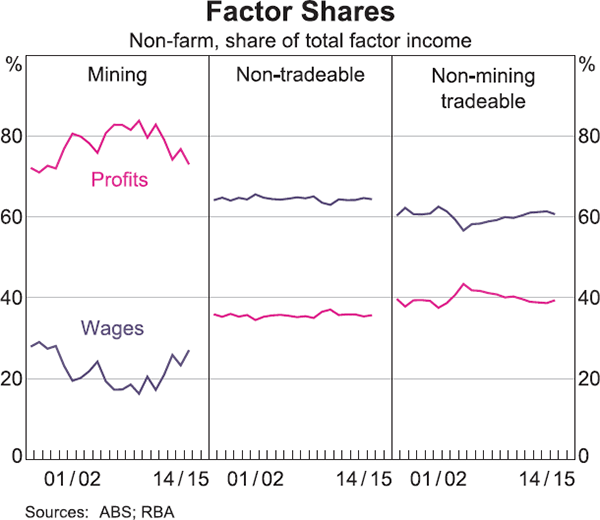
As the mining industry expanded, its demand for inputs from other sectors rose. In the non-tradeable sector, many firms benefited from providing goods and services to the mining industry, including construction, engineering, legal and accounting services (Rayner and Bishop 2013). More broadly, demand for non-tradeable goods and services rose in response to the general increase in earnings and government revenues, as well as tax cuts, associated with the terms of trade boom. This increase in demand led to an increase in output price inflation in the non-tradeable sector.
The non-tradeable sector also sought to attract workers to satisfy the increased demand for its output. The increase in employee earnings necessary to attract the labour desired by the non-tradeable sector was broadly similar to the increase in the sector's output prices, so its real production wage remained little changed for a time. Productivity continued to grow, although at a slower pace than during the late 1990s. Combined, this meant that real unit labour costs declined a little.[4]
The non-mining tradeable sector did not experience such favourable conditions. While some firms in the sector saw an increase in demand for their output from the mining sector (in the manufacturing or wholesale trade industries, for example), demand for goods and services produced by many tradeable firms declined as the Australian dollar appreciated. Overall, the non-mining tradeable sector experienced a more modest increase in its output prices than other sectors.
At the same time, the non-mining tradeable sector had to compete with other sectors for labour. Growth in employee earnings in the non-mining tradeable sector outpaced growth in output prices, so the real production wage rose. The real production wage grew by a little more than labour productivity, so real unit labour costs also picked up. Australian labour became less competitive relative to labour overseas, as nominal unit labour cost growth in Australia outpaced that in many comparable economies and the Australian dollar appreciated. Not surprisingly then, non-mining tradeable firms sought to contain their Australian labour costs. While employment in the non-mining tradeable sector had been declining as a share of total employment since the 1960s, this decline accelerated somewhat during the terms of trade boom.
In aggregate, however, Australian firms saw a notable increase in their output prices (Graph 6). As they sought to expand and attract additional workers, employee earnings increased by a similar amount. Taken together, this meant that the aggregate real production wage was little changed throughout most of the boom (Graph 7). While aggregate labour productivity growth slowed from its strong pace in the late 1990s, it still grew by more than the real production wage, leading to a continuation of the decline in real unit labour costs. As a result, an increasing share of the rising national income accrued to firms during the boom, continuing the trend of previous decades (Graph 8). Demand for labour increased notably, driving the unemployment rate down to 4 per cent (Graph 9).
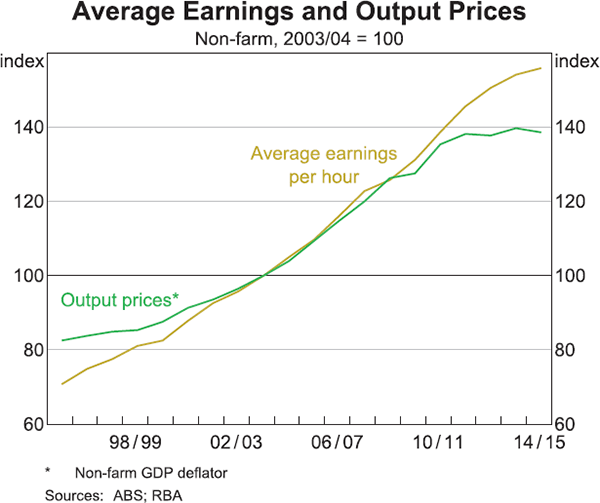
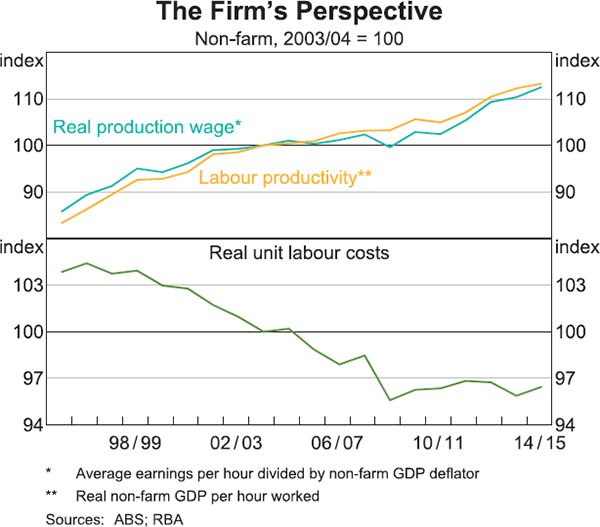
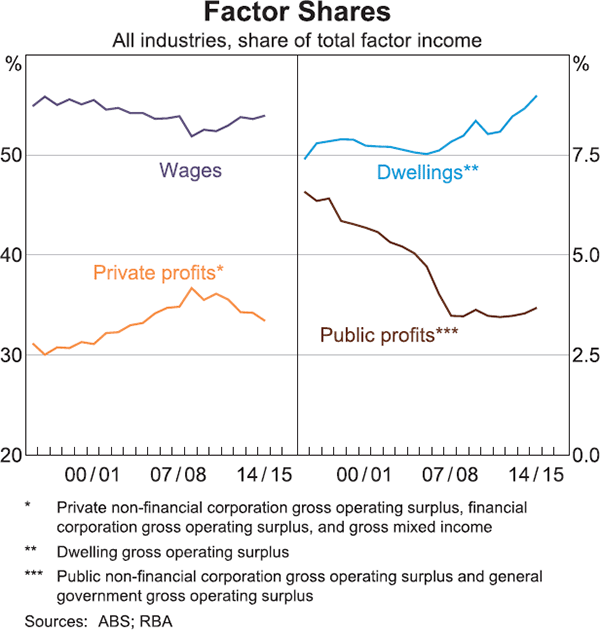
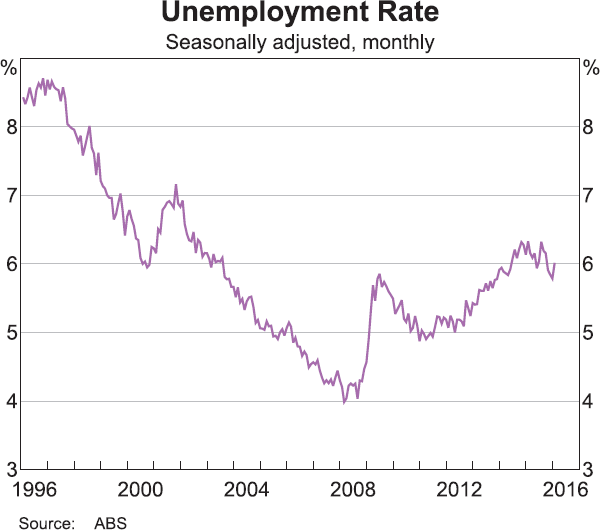
The effect on households
The pace of growth in employee earnings increased during the boom, as did growth in prices of non-tradeable goods and services. However, declining import prices due to the exchange rate appreciation helped to constrain consumption price inflation. The real consumption wage increased by 17 per cent between 2003/04 and 2011/12, even though the real production wage was little changed (Graph 10).[5]
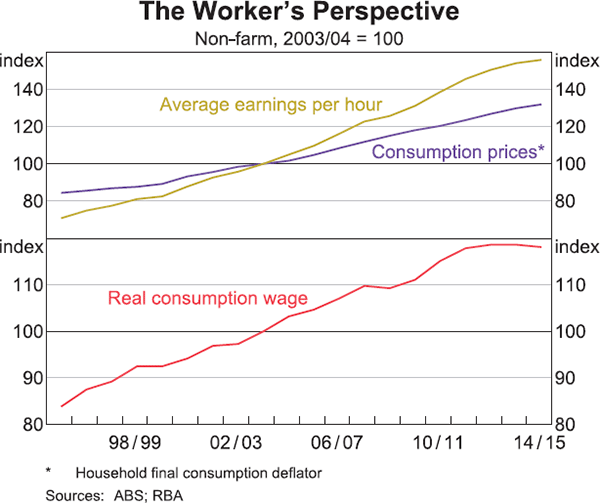
The rise in the real consumption wage may have encouraged more people to enter the labour force. The effect of higher real wages on the labour supply is theoretically ambiguous: households may work more in response to higher wages, or they may choose to work less because they can achieve the same level of income with fewer hours of work. Between 2003/04 and 2010/11, the labour force participation rate increased by almost 2 percentage points. This was partly due to the long-run upward trend in female participation in the workforce, but higher employee earnings and improved employment prospects may have also played a role. In addition, an increase in net immigration contributed to growth in the labour supply. The number of skilled workers entering Australia on temporary work (457) visas increased to meet labour shortages. There was also a larger net inflow of New Zealand citizens and working holiday makers who were seeking to take advantage of the relatively strong job and earnings prospects in Australia.
Employment also responded to differences in job opportunities across sectors and states. Narrowly defined, mining employment doubled as a share of total employment, from 1 per cent to 2 per cent between 2003/04 and 2011/12 (Graph 11). Mining-related employment in other industries also increased sharply. A range of workers transitioned from non-mining-related jobs to similar positions servicing the mining industry, such as chefs, accountants and truck drivers. Employment growth in the non-tradeable sector also picked up during the boom, and its share of total employment increased. The increase in the supply of labour was more pronounced in the mining states of Western Australia and Queensland, which experienced higher net overseas migration, an increase in interstate migration, and a larger increase in the participation rate than other states (Graph 12 and Graph 13).[6]
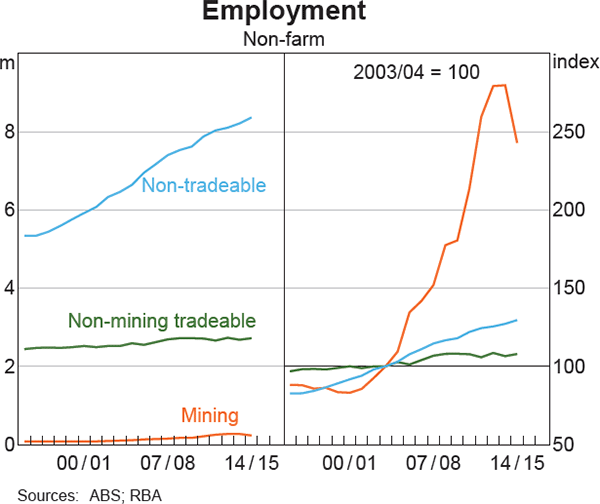
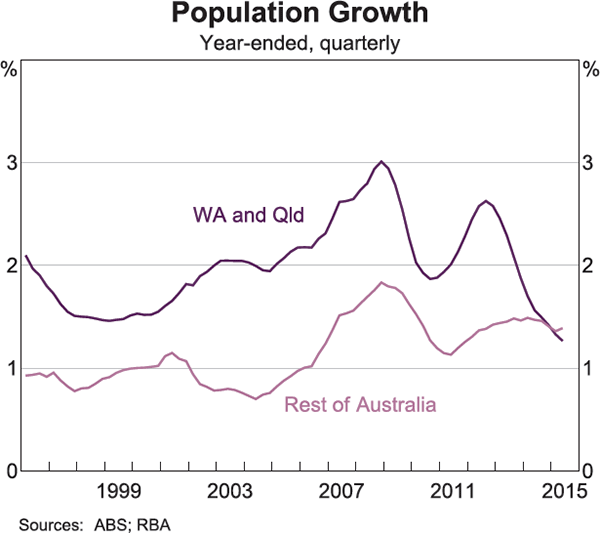
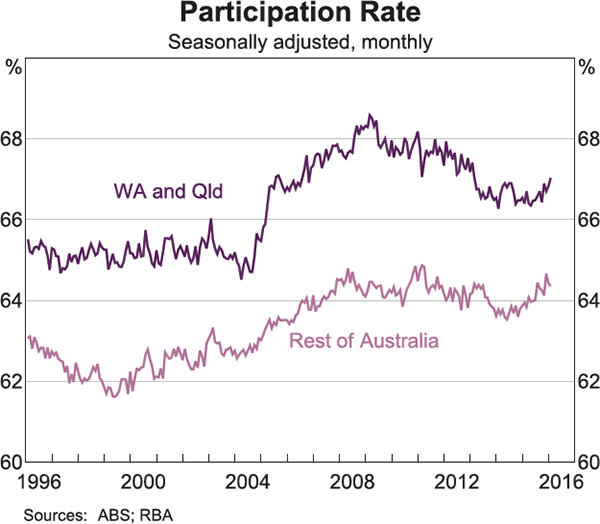
After the Boom
The effect on businesses
The decline in the terms of trade since 2011/12 and the exchange rate depreciation since 2012/13 have begun to reverse some, but not all, of the changes in the labour market that occurred during the boom. In aggregate, combining mining and non-mining industries, Australian firms' output prices have been little changed since the peak in the terms of trade (Graph 6). Accordingly, they have sought to restrain the pace of growth in employee earnings. The decline in the growth of employee earnings appears to have been larger than implied by the historical relationship with the unemployment rate (Jacobs and Rush 2015). While employee earnings growth has outpaced growth in output prices, and the real production wage has increased, this has been matched by an improvement in aggregate labour productivity (Graph 7). As a result, aggregate real unit labour costs have been broadly unchanged. The flexibility in employee earnings growth has prevented real unit labour costs from rising. This has provided some support to aggregate employment growth and so the unemployment rate has not risen to the extent that might otherwise have been expected.
Underlying the aggregate picture, the mining industry's output prices have declined sharply as commodity prices have fallen. Some of this decline in commodity prices was expected to occur as new resource projects in Australia and overseas began production. In anticipation of this, mining firms had limited their commitments for additional investment spending; that is, it was always to be expected that mining investment would decline. Mining production requires fewer workers than mining investment, so the mining industry's demand for workers was also expected to fall. However, commodity prices have declined by even more than anticipated, which has further reduced mining labour demand and led mining firms to attempt to reduce their labour costs more generally (Gorajek and Rees 2015).
Mining employee earnings stopped rising a few years before mining output prices peaked and were unchanged for some time (Graph 3). In 2014/15, mining employment started to decline, falling by 35,000 (Graph 11). Surprisingly, average employee earnings increased sharply in 2014/15, even though mining wage growth as measured by the wage price index continued to decline. This increase in average earnings was likely to reflect a change in the composition of mining employment towards more highly paid workers, as well as redundancy payments. Mining labour productivity also picked up in 2014/15, with employment declining and production increasing.
However, the increase in labour productivity in the mining sector was not sufficient to prevent mining real unit labour costs rising markedly over the past few years (Graph 4). The decline in the mining sector's income has been more heavily borne by profits; the wage share of mining income has returned to around its pre-boom levels (Graph 5).
The end of the boom in commodity prices and mining investment has had considerable flow-on effects to other sectors. The Bank's business liaison suggests that broad cost-cutting initiatives in the mining industry have placed significant pressure on the margins of its suppliers and these businesses have, in turn, sought to reduce the cost of their own inputs, including labour. Working in the other direction, however, low interest rates and the depreciation of the exchange rate since 2013 have helped to support aggregate demand for Australian produced goods and services.
In the non-tradeable sector, low interest rates have stimulated demand for housing assets and an increase in residential construction has provided employment for some workers laid off from mining-related construction (Doyle 2014). Liaison suggests that many of the construction workers employed in the investment phase of the mining boom had previous experience in civil and residential construction and have been able to return to jobs in these industries (though for a time they were reluctant to do so given the lower wages on offer). Residential construction activity has also provided demand for a range of business services, including for some services that have experienced a decline in demand from the mining sector, such as engineering and legal services.
Output prices in the non-tradeable sector have continued to rise, although at a slower pace than during the resources boom. Liaison suggests that these firms have sought to contain growth in labour costs in response. Growth in employee earnings has declined but not to the same extent as output price inflation. Consequently, the real production wage has risen in this sector. However, labour productivity growth has also picked up since the end of the boom. Real unit labour costs continued to decline for a little while, but have been broadly unchanged over the past couple of years. Employment in the non-tradeable sector has continued to rise, though not at the same pace as during the boom.
Many firms producing tradeable goods and services have also experienced a decline in mining-related demand, but overall they have benefited from the exchange rate depreciation most directly. Australia's services exports have expanded noticeably in the past couple of years, with tourism, education and business services exports rising.[7] Also, imports of services have declined as Australians appear to have switched some of their expenditure to domestically produced services, including domestic holidays rather than overseas holidays. In contrast, manufactured production exports have been little changed for some time, consistent with long-term trends. Meanwhile, output prices for the wholesale industry have come under pressure as competition in the retail sector has intensified, partly because of new entrants.
The combined effect of these developments has been to reduce output price inflation in the non-mining tradeable sector. The demand for labour from tradeable firms has been mixed; some services firms have increased hiring as their exports have risen, but manufacturers and wholesalers have reduced employment. Employee earnings growth in the non-mining tradeable sector has slowed substantially, and the real production wage has stopped increasing. The sector's real unit labour costs have even declined a little over the past few years. Relative to other comparable economies, Australia's nominal unit labour costs have declined slightly. Together with the depreciation of the Australian dollar, this has helped to improve the competitiveness of Australian labour.
The effect on households
Since the peak in the terms of trade in 2011/12, growth in employee earnings has slowed to be in line with consumption price inflation, and the aggregate real consumption wage has been little changed (Graph 10). The Bank's liaison suggests that many employees have been willing to trade lower growth in earnings for greater job security. This may reflect a number of factors including: lingering concerns about job prospects following the global financial crisis; relatively weak wage growth overseas and the increasingly global nature of labour markets; perceptions that there are fewer alternative job opportunities following the end of the mining investment boom; and a decline in the bargaining power of labour. In the non-tradeable sector, growth in the real consumption wage has been less favourable than during the boom. The real consumption wage has fallen in the non-mining tradeable sector, while the mining real consumption wage has been quite volatile (partly due to compositional change).
Mining employment declined sharply in 2014/15, and is expected to fall further in the next few years (Graph 11). Employment in the in non-mining tradeable sector has remained little changed.
Meanwhile, the non-tradeable sector's employment has continued to grow, underpinning the growth in aggregate employment.
Growth in the aggregate labour force appears to have responded to developments in labour demand and real wage growth. The unchanged real consumption wage and more limited job opportunities since the end of the mining investment boom may have made working in Australia less attractive, particularly as labour market conditions have improved overseas. This appears to have been reflected in a decline in population growth owing to a fall in annual net immigration (Graph 12). This partly reflects the departure of temporary workers as many mining-related employment contracts have come to an end. However, there has also been a larger net outflow of Australian citizens and a smaller net inflow of New Zealand citizens and working holiday makers since the end of the mining investment boom. This decline in net immigration has helped the labour market to adjust without the unemployment rate increasing as much as it otherwise might have done. In addition, the labour force participation rate declined by 0.6 percentage points between 2011/12 and 2014/15, although it has recovered somewhat of late. As in the upswing, the decline in the labour force participation rate was most pronounced in the mining states (Graph 13).
Overall, even though labour's share of income has increased a little over recent years, households do not feel better off because the purchasing power of their earnings has not increased and the unemployment rate remains above its level during the boom. Nevertheless, the weaker growth in employee earnings may have encouraged firms to employ more people than otherwise.
Assessment and Outlook
In aggregate, the terms of trade boom was responsible for a large increase in firms' output prices and demand for labour, which led to a significant strengthening of the labour market and boosted the earnings of Australian households. More recently, the Australian labour market has been gradually adjusting to the decline in the terms of trade and the end of the mining investment boom. The decline in the terms of trade has weighed on firms' output prices and mining-related labour demand has fallen. There has also been a notable decline in employee earnings growth which, alongside a pick-up in productivity growth, has helped to improve the competitiveness of Australian labour and encouraged firms to employ more workers than would otherwise have been the case. The labour supply appears to have responded to weaker labour demand and lower earnings growth, with a decline in net immigration over recent years. Meanwhile, the depreciation of the exchange rate and low interest rates are working to support aggregate demand. While the unemployment rate remains higher than it was during the boom, it has declined a little over the past year or so. Many workers have been able to move from mining-related jobs to similar positions in the non-mining economy. While the adjustment still has a way to go and a further decline in mining-related labour demand is expected over coming years, the flexibility of the labour market to date bodes well for this continued transition.
Footnotes
The authors are from Economic Analysis Department. Jonathan Bridges was in Economic Analysis Department during his secondment from the Bank of England. [*]
Most of the data used in this article are drawn from the national accounts. For consistency, consumption prices are defined by the household final consumption expenditure implicit price deflator from the national accounts, which differs somewhat from the Consumer Price Index (for detail see ABS 2011). [1]
Henceforth, employee average hourly earnings are referred to as employee earnings. [2]
Following Plumb et al (2013) and Gorajek and Rees (2015), the economy is divided into three sectors: mining (2 per cent of employment); non-mining tradeables, where exports or competing imports are a large share of gross output: manufacturing, transport, wholesale trade, and accommodation & food services (23 per cent of employment); and non-tradeables, where exports or competing imports are relatively small share of gross output, such as the majority of household and business services (72 per cent of employment). Agriculture is not included as it was affected by weather-related developments not covered in this analysis. [3]
While real unit labour costs declined in non-tradeable industries during the boom, the measured wage share of income was little changed. This is because real unit labour costs include the imputed cost of payments to self-employed persons, and self-employment declined as a share of total employment; payments to self-employed persons are not included in the wage share. [4]
The labour market was only one of many channels through which Australian households benefited from the terms of trade boom; another significant channel was the tax cuts associated with the increase in government revenues (RBA 2015). [5]
The increase in the participation rate may have reflected local workers joining the labour force in response to the higher returns to working. It may also have reflected the inflow of migrants, who have a higher propensity to participate in the workforce than the existing population. [6]
Unfortunately, the tradeable components of education and business services are not included in the graphs in this article due to limited granularity in the data. A larger proportion of these industries cater to domestic demand than to overseas demand and, therefore, these industries are classified as non-tradeable. [7]
References
ABS (Australian Bureau of Statistics) (2011), ‘Consumer Price Index: Concepts, Sources and Methods’, ABS Cat No 6461.0, December, pp 121–122.
Downes P, K Hanslow and P Tulip (2014), ‘The Effect of the Mining Boom on the Australian Economy’, RBA Research Discussion Paper No 2014-08.
Doyle M-A (2014), ‘Labour Movements during the Resources Boom’, RBA Bulletin, December, pp 7–16.
Gorajek A & D Rees (2015), ‘Lower Bulk Commodity Prices and Their Effect on Economic Activity’, RBA Bulletin, September, pp 31–38.
Jacobs D and A Rush (2015), ‘Why is Wage Growth so Low?’, RBA Bulletin, June, pp 9–18.
Plumb M, C Kent and J Bishop (2013), ‘Implications for the Australian Economy of Strong Growth in Asia’, RBA Research Discussion Paper No 2013-03.
Rayner V and J Bishop (2013), ‘Industry Dimensions of the Resource Boom: An Input-Output Analysis’, RBA Research Discussion Paper No 2013-02.
RBA (Reserve Bank of Australia) (2015), ‘Box A: The Effects of Changes in Iron Ore Prices’, Statement on Monetary Policy, February, pp 13–16.